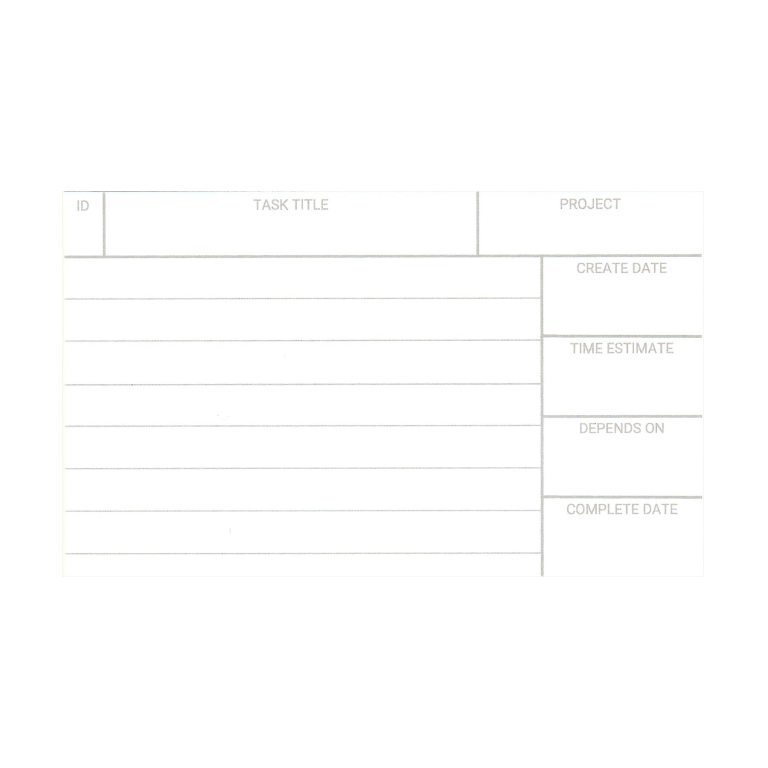- Dec 2025
-
www.youtube.com www.youtube.com
Tags
Annotators
URL
-
-
www.youtube.com www.youtube.com
-
FILING PROCEDURES IN BUSINESS 1965 OFFICE MANAGEMENT / SECRETARY TRAINING FILM 62244<br /> by [[Periscope Film]] on YouTube<br /> accessed on 2025-12-03T00:14:39
-
-
Local file Local file
-
UBJECT filing is a branch of filingwhich is not much used in thebusiness world but which deservesas much attention as any other. It ismore complicated than other systemsand an adaptation has to be workedout for each , business to which it isapplied, but after the classification hasonce been made, it will prove to be foreconomy and increased efficiency.
-
- Nov 2025
-
Local file Local file
-
Hunter, Estelle Belle. 1923. Modern Filing Manual. Rochester, NY: Yawman and Erbe Manufacturing Company. https://www.google.com/books/edition/Modern_Filing_Manual/F-lNAQAAMAAJ?hl=en.
-
- Feb 2025
-
www.google.com www.google.com
-
There was no office machinery at all–the typewriter was known but scarcely used. Even telephones were rarities. The card index, the filing cabinet, the loose-leaf ledger were all but unknown. Of course there were no calculating machines.
System, the Magazine of Business, volume XLII, Number 5, November 1922, p536, "What 55 Years in Business Taught Me About Managing: The first installment of the biography of John H. Patterson, founder of the National Cash Register Company and Lately Chairman of the Board" by Samuel Crowther.
-
-
warrenpaper.com warrenpaper.com
- Oct 2024
-
Local file Local file
-
At first, also, it might be thought that the Cardswould be inconvenient to use, but the personal ex-perience of thousands shows that, at any rate forbusiness-purposes, exactly the reverse is true
Miles' uses the ubiquity of card systems (even at the writing in 1899, prior to publication) within business as evidence for bolstering their use in writing and composition.
(Recall that he's also writing in the UK.)
-
- Sep 2024
-
www.google.com www.google.com
-
https://www.google.com/books/edition/Geyer_s_Stationer/Ml7lJzdUNFIC?hl=en&gbpv=0<br /> Geyer's Stationer<br /> Devoted to the Interests of the Stationery, Fancy Goods and Notion Trades · Volume 82<br /> 1926
page 36 of the 1926 December issue has a "Rapidex" product for the telephone which sounds ostensibly like a Rolodex-type system
-
-
archive.org archive.org
-
Macey Filing Appliances 1906<br /> Catalogue No. 4206<br /> The Macey Co.<br /> https://archive.org/details/macey-filing-appliances-1906/mode/2up
-
-
archive.org archive.org
-
https://archive.org/details/catalog00fred/mode/2up
Fred Macey Company Catalog (1910)
-
- Aug 2024
-
typewriter-museum.lv typewriter-museum.lv
- Apr 2024
-
-
The Varidex is the name given to onemethod-a direct expanding index made inletter , bill and le gal sizes. In this systemthe general plan of tab positions is similarto the direct alphabetic system. It main-tains the fam iliar sectional arrangementfor guide s, individual and )Jliscellaneousfo ld er s.
-
-
archive.org archive.org
-
[Narrator]: The Cluttered Desk, Index Card,file folders, the in-out basket, the calculator.These are the tools of the office professional's past.Since the dawn of the computer age, better machines have always meant bigger and more powerful.But the software could not accommodate the needs of office professionals who are responsiblefor the look, shape and feel of tomorrow.
In 1983, at the dawn of the personal computer age, Apple Inc. in promotional film entitled "Lisa Soul Of A New Machine" touted their new computer, a 16-bit dual disk drive "personal office system", as something that would do away with "the cluttered desk, index cards, file folders, the in-out basket, [and] the calculator." (00:01)
Some of these things moved to the realm of the computer including the messy desk(top) now giving people two messy desks, a real one and a virtual one. The database-like structure of the card index also moved over, but the subjective index and its search power were substituted for a lower level concordance search.
30 years on, for most people, the value of the database idea behind the humble "index card" has long since disappeared and so it seems here as if it's "just" another piece of cluttery paper.
Appreciate the rosy framing of the juxtaposition of "past" and "future" jumping over the idea of the here and now which includes the thing they're selling, the Lisa computer. They're selling the idealized and unclear future even though it's really just today.
-
-
archive.org archive.org
-
(13:39) Hands flipping through a card index with overlapping dialogue about prospects
https://archive.org/details/0800_Beware_of_Mental-itis_06_00_55_00
-
-
Local file Local file
-
You cannot buy a ready-made intelligence departmenton which to run your business.
-
The subject is treated quite dispassionately,no particular file or cabinet is thrust upon the reader, but the re-quirements of ideal appliances and the state of existing ones aredescribed.
Further evidence to the claim at https://hypothes.is/a/iQwqzvC4Ee6PrNfzDQurog
-
Automobile and Carriage Builders' Journal, October 1908. Duringthe last five or six years the carriage builder has been adopting,perhaps slowly, and often unwillingly, the card system in his office.,owing to the extra detail the motor business has brought with it.It will have probably been introduced by a new partner who hasbrought new money into the business, when extra funds were necessaryto cope with the new state of affairs. The motor manufacturer usesit instinctively, for he brings with him,
as a rule, the law, order, and precision of an engineer's office.
There's an interesting dichotomy presented here about the tech forwardness of the automobile industry in 1908 versus the tech reticence of the carriage builders in regard to adopting card indexes with respect to their related (though different) industries.
Me (sarcastically):<br /> "Oh, those backwards carriage builders will get with the 'program' any day now..."
-
card system are indebted tothese catalogues for their information. But all these publications areprimarily concerned with the particular cabinet or file of the firm inwhose interest they are published.
Variations of card index systems were published in booklet form by filing cabinet manufacturers as a means of selling not only their cabinets, but their systems for using them was common in the early 1900s. Examples of magazine advertisements in System Magazine back this up. It is also specifically highlighted in a review of J. Kaiser's book "The Card System at the Office" from Ironmonger (1909-10-03) which appreciates a more fully fleshed out version of a card index system in book form without mention of specific manufacturing firms.
-
o businesses of varied sizes are set forth and their working illustrated."We note with appreciation the author's use of "flags" as indic.itors.Our experience of these handy and ingenious little devices datesfrom their first introduction in the States, and we can endorse all that"he says in their favour.
When were bookmark-like "flags" introduced in America? (Certainly prior to 1908, based on this reference.)
-
Yet it is doubtful whether since theintroduction of the typewriter there has been an invention so beneficialto modern business as the card-index system.
-
-
Local file Local file
-
Kaiser, J. Card System at the Office. The Card System Series 1. London: Vacher and Sons, 1908. http://archive.org/details/cardsystematoffi00kaisrich.
Annotation url: urn:x-pdf:01c6d04ce30f5072bccfd0b7ea69d9d2
-
A four drawer cabinetis as a rule ample for the purposes of the key cabinet.
Key cabinets are used to control the information found in other card indexes as well as for private business information which should be restricted within a firm.
-
Business In former years the account ledger representedLedger
Business Ledger
This section looks at index cards for communication to/from clients and appropriate follow up with respect to sales management in a manufacturing firm. It broadly represents some examples of how one would do larger scale project management and follow up with index cards.
-
Summaries*
examples of specific workflows within Kaiser's card system
-
- Mar 2024
-
Local file Local file
-
163
Early 20th century mail merge using a card index!
-
Elaborate library classifications were either inapplicable or much 74too complicated and therefore unmanageable. Their applicationto business was out of the question. Something simple, easy toimderstand and easy to handle was required. This was foundin the numerical arrangement. The numerical classification inspite of its arbitrary character will always have this advantagethat it ensures accuracy with the least trouble, and this is stillmore the case where large quantities are handled. It was quitenatural therefore that this should be preferred for business purposes.As there are many sets of things arranged numerically, it isnecessary to distinguish one set from the other, so as to know towhat set a given number refers. This is done by affixing dis-tinguishing initials to the numbers, each class being assigned somecharacteristic initial of its own.
In describing classification schemes for card index-based business uses, Julius Kaiser indicated in 1908 that "elaborate library classifications were either inapplicable or much too complicated and therefore unmanageable." This is in part because of the standardization of the Dewey Decimal System, which may have provided efficiencies for library systems, but proved too rigid for the idiosyncrasies of a variety of businesses. Instead he describes an alpha-numeric system in which numbers provide simple means of finding while the initial alphabetic codes assign specific office-related classes (correspondence, press cuttings, catalogs, etc.) to the indexed materials.
-
The development of the card system and itsmore universal adoption within recent years isundoubtedly due in the mail to the development in modernbusiness and factory organisation ; it may be regarded as anoffspring of manufacture in quantities. (Massenfabrikation, Gross-industrie.) The recognised principle in manufacture in quantities ismaximum of output with minimum of labour. The means to attainthis end is specialisation, which in its turn yields greater precisionand accuracy as it^ result. All this is equally applicable to thecard system, and the last factor, greater precision and accuracy,is one of its most conspicuous claims.
Julius Kaiser contemporaneously posits that mass manufacture and maximizing efficiency (greater output for minimum input) are the primary drivers of card index system use in the early 20th century. These also improve both precision and accuracy in handling information which allow for better company or factory operation, which would have been rising concerns for businesses and manufacturing operations at the rise of scientific management during the time period.
-
Volume 2 will be almost entirelydevoted to the work of indexing in the sense of analysing literatureand will go more fully into the question of classification and themanagement of guide cards. The present volume is confined asfar as practicable to the use of plain cards. Tabulated cards,methods of tabulating and the application of tabulated cards topractical business will be dealt with in volume 3, " The CardSystem at the Factory."
companion volumes treated the topics of "analysing literature" and the application of tabulated cards to practical business "at the Factory".
see: Kaiser, J. Systematic Indexing. The Card System Series 2. London: Sir Isaac Pitman & Sons, Ltd., 1911. http://archive.org/details/systematicindexi00kaisuoft.
-
Office Organisation, of which the work here discussed forms part, 2has been considerably modified within recent years, and Avhatis called the " card system " has now come very much into vogue.
The nebulous, but colloquial "card system" was a common, but now lost moniker for the use of a card index in business settings in the early 1900s.
-
- Jan 2024
-
forum.zettelkasten.de forum.zettelkasten.de
-
Chris, I read it some 40 years ago when as a school boy I began with my Zettelkasten journey. It is about the technique as well as the intellectuell framework behind it and was surely pointed to business aspects as well as running the civil service but also outspoken to the worker of the mind, the scientist and philosopher. Filing and indexing is crucial to all of these varied aspects of cultural life. But don't expect hitherto unknown magical practices to be revealed. It was commune practice then and you could find handbooks on indexing and filing in organisations also in America and England at that time. The new found way of personal knowlegde management just doesn't know about its predecessors with pen, ink, typewriter and other unbeliefable tricks.
quote from Martin <br /> https://forum.zettelkasten.de/discussion/comment/19435#Comment_19435 on 2024-01-28
-
- Oct 2023
-
-
MONDAY, NOVEMBER 2, 1942Dear Kitty,Bep stayed with us Friday evening. It was fun, but she didn’t sleepvery well because she’d drunk some wine. For the rest, there’snothing special to report. I had an awful headache yesterday andwent to bed early. Margot’s being exasperating again.This morning I began sorting out an index card �le from theo�ce, because it’d fallen over and gotten all mixed up. Before long Iwas going nuts. I asked Margot and Peter to help, but they were toolazy, so I put it away. I’m not crazy enough to do it all by myself!Anne Frank
In a diary entry dated Monday, November 2, 1942, Anne Frank in an entry in which she includes a post script about the "important news that [she's] probably going to get [her] period soon." she mentions spending some time sorting out an index card file. Presumably it had been used for business purposes as she mentions that she got it from the office. Given that it had "fallen over and gotten all mixed up", it presumably didn't use a card rod to hold the cards in. It must have been a fairly big task as she asked for help from two people and not getting it, she abandoned the task because, as she wrote: "I'm not crazy enough to do it all by myself!"
-
- Mar 2023
-
-
Wigent, William David, Burton David William Housel, and Edward Harry Gilman. Modern Filing and How to File: A Textbook on Office System. Rochester, N.Y.: Yawman & Erbe Mfg. Co., 1916. http://archive.org/details/modernfilingate02compgoog.
Original .pdf converted with docdrop.org for OCR annotation on 2023-03-24.
annotation target: urn:x-pdf:3c1f14d64c91cf4b513efa16df4ed90d
Annotations: https://hypothes.is/users/chrisaldrich?q=url%3Aurn%3Ax-pdf%3A3c1f14d64c91cf4b513efa16df4ed90d
-
-
archive.org archive.org
-
Wigent, William David, Burton David William Housel, and Edward Harry Gilman. Modern Filing and How to File: A Textbook on Office System. Rochester, N.Y.: Yawman & Erbe Mfg. Co., 1916. http://archive.org/details/modernfilingate02compgoog.
-
-
archive.org archive.org
-
Shaw-Walker. Flexowriter File-Desks. Accessed March 24, 2023. http://archive.org/details/TNM_Flexowriter_File-Desks_-_Shaw-Walker_20171021_0001.
An interesting in-desk filing system for punched cards. Interesting I've not seen anything like this prior for a mini card index maintained in an office desk drawer.
Perhaps such a system wouldn't have been as easily accessible for use on a daily basis versus potentially more portable small systems that could have been transferred from desk to desk (person to person).
-
-
niklas-luhmann-archiv.de niklas-luhmann-archiv.de
-
9/8b2 "Multiple storage" als Notwendigkeit derSpeicherung von komplexen (komplex auszu-wertenden) Informationen.
Seems like from a historical perspective hierarchical databases were more prevalent in the 1960s and relational databases didn't exist until the 1970s. (check references for this historically)
Of course one must consider that within a card index or zettelkasten the ideas of both could have co-existed in essence even if they weren't named as such. Some of the business use cases as early as 1903 (earlier?) would have shown the idea of multiple storage and relational database usage. Beatrice Webb's usage of her notes in a database-like way may have indicated this as well.
-
-
www.ebay.com www.ebay.com
-
https://www.ebay.com/itm/115727768658
The Shaw=Walker Card Systems catalogue from circa 1899.
-
-
www.google.com www.google.com
-
Seen in a Hoskins business equipment advertisement in Business magazine (1903) for card index:
YOUR BUSINESS AT YOUR FINGER ENDS
Close to the phrase "at your finger tips". Would it have appeared before or after this?
Business: The Magazine for Office, Store and Factory. Vol. 16. Business Man’s Publishing Company, 1903. https://www.google.com/books/edition/Business/QKaxezfHjL0C?hl=en&gbpv=0.
-
-
inst-fs-iad-prod.inscloudgate.net inst-fs-iad-prod.inscloudgate.netcontent1
-
mindex.THIS is the name Howard L. Wilson, of Rochester, N.Y.,hasgivenhisvestpocket cardsystem.Itisa
Geyers Stationer. “Memindex Advertisement.” Geyer’s Stationer: Devoted to the Interests of the Stationery, Fancy Goods and Notion Trades, September 15, 1904. https://www.google.com/books/edition/Geyer_s_Stationer/L507AQAAMAAJ?hl=en&gbpv=0
Howard L. Wilson of Rochester, NY named his vest pocket card index system the Memindex.
-
-
-
STANDARD INDEX CARD CO.
Fascinating to see the 8 various types of hole punches different card index systems may have used on their index card filing cabinets.
Advertisement from System, December 1906:
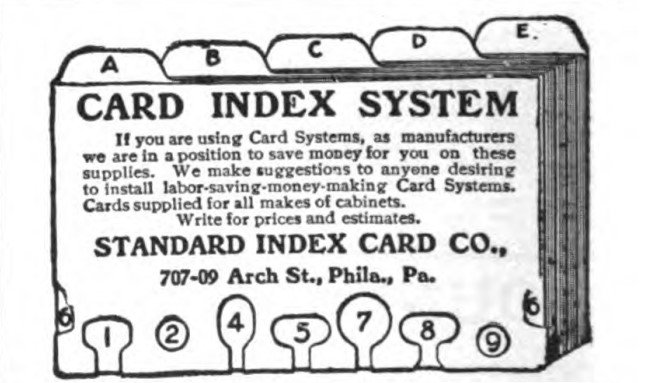
CARD INDEX SYSTEM <br /> If you are using Card Systems, as manufacturers we are in a position to save money for you on these supplies. We make suggestions to anyone desiring to install labor-saving-money- making Card Systems.<br /> Cards supplied for all makes of cabinets.<br /> Write for prices and estimates.<br /> STANDARD INDEX CARD CO.,<br /> 707-09 Arch St., Phila., Pa.
-
TheCalculagraph
Beyond having people make direct copies of cards by hand or using carbon paper, The Calculagraph Company manufactured a copying machine for duplicating data.
There is an accompanying picture (which I haven't copied here). Advertisement from 1906 System Magazine:
The Calculagraph<br /> Makes individual records of actual<br /> working time on separate cards<br /> which may be used interchangeably<br /> for Cost Accounting, for Pay-rolls and<br /> for a number of other purposes with-<br /> out copying or transcribing a single<br /> figure, by simply assorting the cards<br /> and adding the records directly from<br /> their faces.<br /> A card containing all the work<br /> records of one man for a week may<br /> be useful for pay-roll purposes, but it<br /> is utterly worthless for learning the<br /> cost of products, until all the items<br /> have been copied or transcribed for<br /> classification.<br /> The Calculagraph requires a large<br /> number of cards in a factory employ-<br /> ing several hundred persons, but it<br /> Saves Clerical Labor. (In one<br /> factory it saves $150.00 per week).<br /> Cards Are Cheaper Than Labor<br /> The Calculagraph Makes No<br /> Clerical Errors.<br /> Let us send you our printed matter.<br /> CALCULAGRAPH COMPANY<br /> 1414 JEWELERS BUILDING, NEW YORK CITY
-
TheSateliteCombinationCard IndexCabinetandTelephoneStand
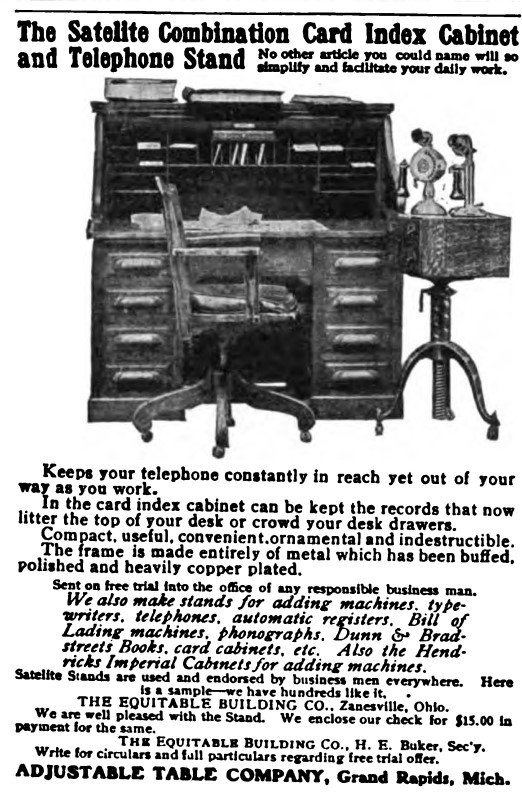
A fascinating combination of office furniture types in 1906!
The Adjustable Table Company of Grand Rapids, Michigan manufactured a combination table for both telephones and index cards. It was designed as an accessory to be stood next to one's desk to accommodate a telephone at the beginning of the telephone era and also served as storage for one's card index.
Given the broad business-based use of the card index at the time and the newness of the telephone, this piece of furniture likely was not designed as an early proto-rolodex, though it certainly could have been (and very well may have likely been) used as such in practice.
I totally want one of these as a side table for my couch/reading chair for both storing index cards and as a temporary writing surface while reading!
This could also be an early precursor to Twitter!
Folks have certainly mentioned other incarnations: - annotations in books (person to self), - postcards (person to person), - the telegraph (person to person and possibly to others by personal communication or newspaper distribution)
but this is the first version of short note user interface for both creation, storage, and distribution by means of electrical transmission (via telephone) with a bigger network (still person to person, but with potential for easy/cheap distribution to more than a single person)
-
W.K.Kellogg,President ofthe ToastedCornFlakeCompanyandalliedBattleCreekinterestsusing 640 drawers,says:"Ourbusiness involvesthehandling ofavastamountofdetail.Thedaily mailsometimescontainsthousandsofletters.IdonotknowhowallthesedetailscouldpossiblyhavebeenhandledwithoutShaw-WalkerSystems.
In the December 1906 issue of System, a magazine which would eventually become Bloomberg Business Week), W. K. Kellogg, the President of the Toasted Corn Flake Company is quoted touting the invaluable nature of the Shaw-Walker filing system at a time when his company was using 640 drawers of their system.
Tags
- audience
- zettelkasten boxes
- annotations
- technology
- clerical errors
- Calculagraph
- postcards
- copyists
- Philadelphia Pennsylvania
- satelite stands
- Shaw-Walker
- W. K. Kellogg
- accounting influence on note taking
- Grand Rapids Michigan
- evolution of technology
- card index filing cabinets
- economics
- Adjustable Table Company
- Standard Index Card Co.
- 1906
- filing cabinets
- office furniture
- accounting
- card index for business
- user interface
- Corn Flakes
- telephones
- copying
- rolodexes
- intellectual history
- telegraph
Annotators
-
-
www.ebay.com www.ebay.com
-
Antique Calculagraph Machine Time Clock Card Recorder Old Factory Punch Vintage
https://www.ebay.com/itm/293124175605
For advertisement from 1906, see: https://hypothes.is/a/OGREvL98Ee2mYVO2Fqim6Q
-
-
www.ebay.com www.ebay.com
-
Vintage 1900 Macey Card Business System Fred Macey Company Original Ad 1021 A2<br />

https://www.ebay.com/itm/275147213477
Copy in notes folder as backup
-
-
www.ebay.com www.ebay.com
-

Copy in Notes folder.
-
- Feb 2023
-
www.srf.ch www.srf.ch
-
Stettler, Lucia. “Geheime Gästekartei überlebt Hotelbrand – und birgt Zündstoff.” Schweizer Radio und Fernsehen (SRF), April 8, 2021, sec. Kultur. https://www.srf.ch/kultur/gesellschaft-religion/brisanter-fund-geheime-gaestekartei-ueberlebt-hotelbrand-und-birgt-zuendstoff.
<small><cite class='h-cite via'>ᔥ <span class='p-author h-card'>ManuelRodriguez331</span> in Advantages of Analog note taking : Zettelkasten (<time class='dt-published'>02/07/2023 08:33:25</time>)</cite></small>
-
Wie durch ein Wunder blieben vier Holzkisten mit hochbrisantem Inhalt verschont. Sie waren zum Zeitpunkt des Infernos in einem anderen Gebäude eingelagert. Sie enthielten 20'000 Gästekarten, die Concierges und Rezeptionisten zwischen 1920 und 1960 heimlich geführt hatten.
Google translate:
four wooden boxes with highly explosive contents were spared. They were stored in a different building at the time of the inferno. They contained 20,000 guest cards that concierges and receptionists had kept secretly between 1920 and 1960.
The Grandhotel Waldhaus burned down in 1989, but saved from the inferno were 20,000 guest cards with annotations about them that were compiled between 1920 and 1960.
-
At the Grandhotel Waldhaus in Vulpera, Switzerland concierges and receptionists maintained a business-focused zettelkasten of cards. In addition to the typical business function these cards served denoting names, addresses, and rooms, the staff also made annotations commenting on the guests and their proclivities.
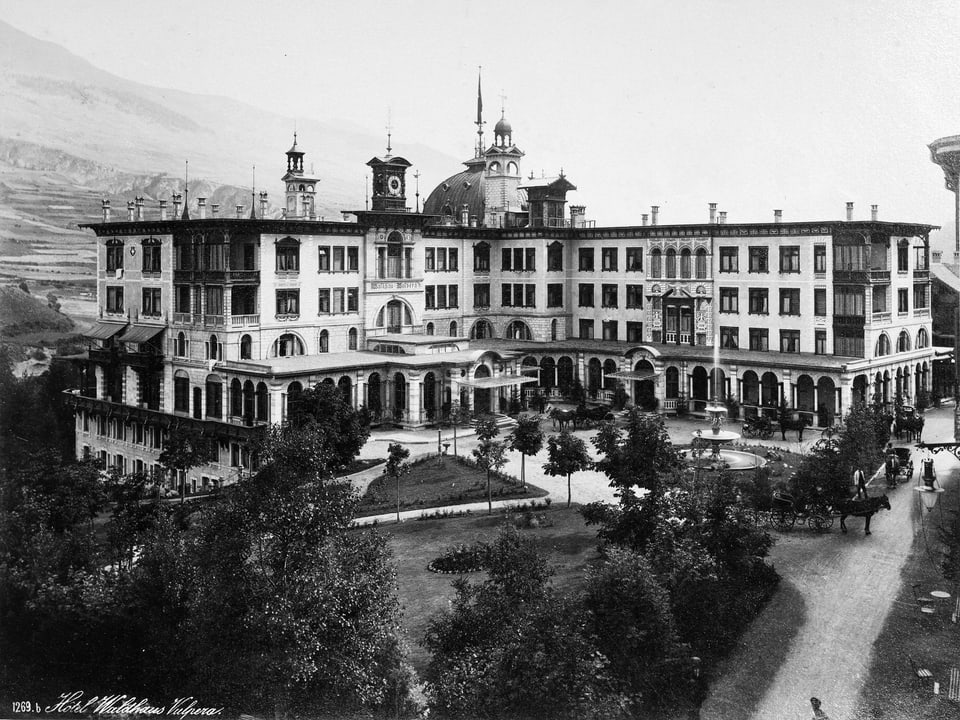
1:
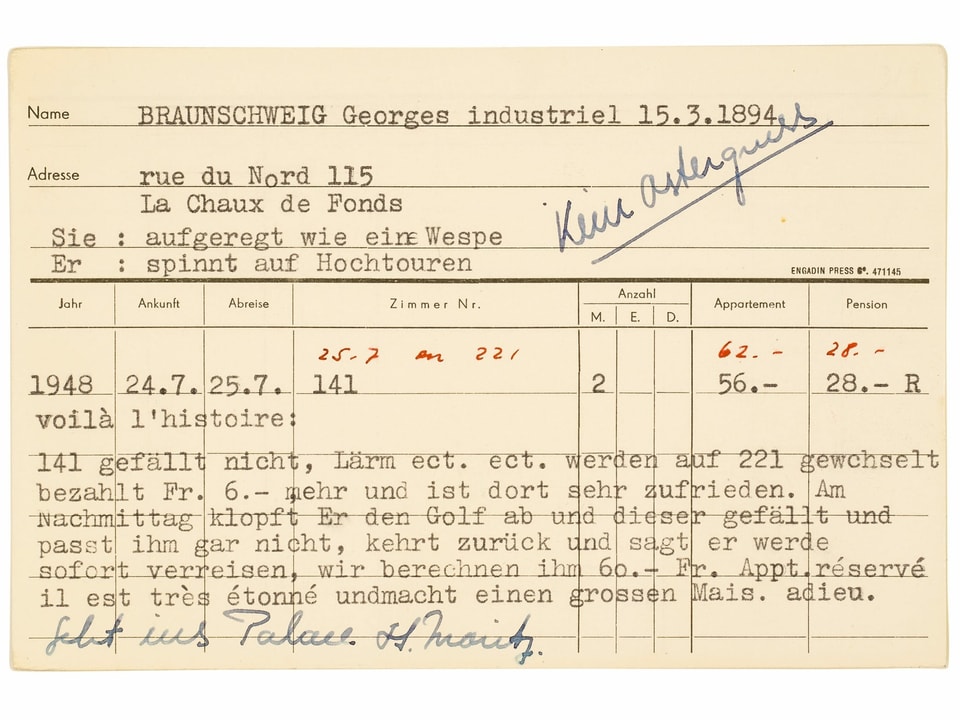
2:
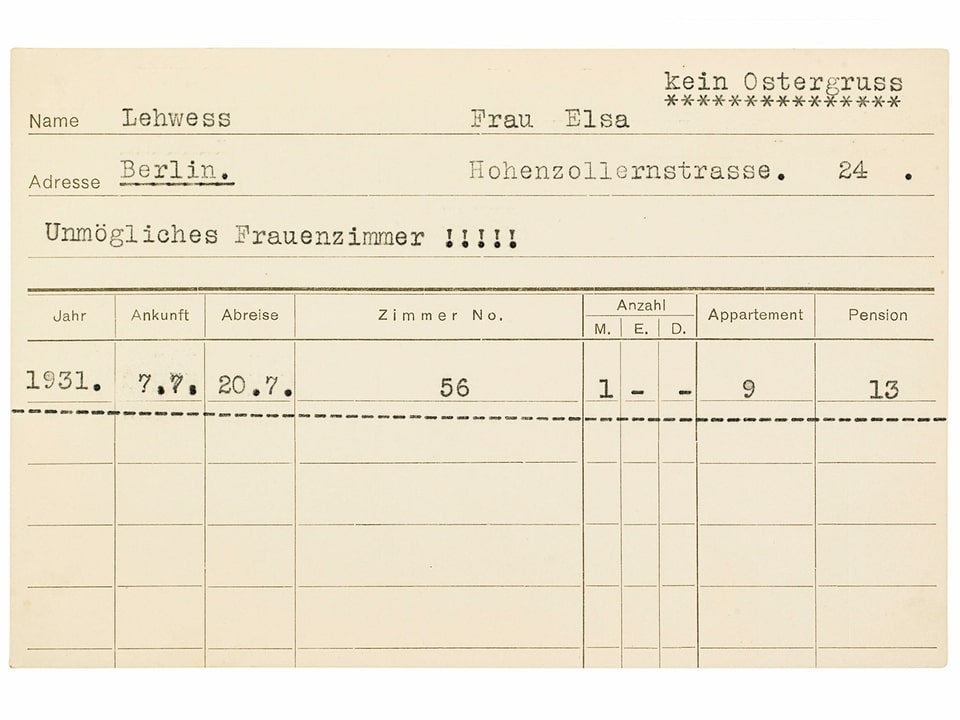
3:
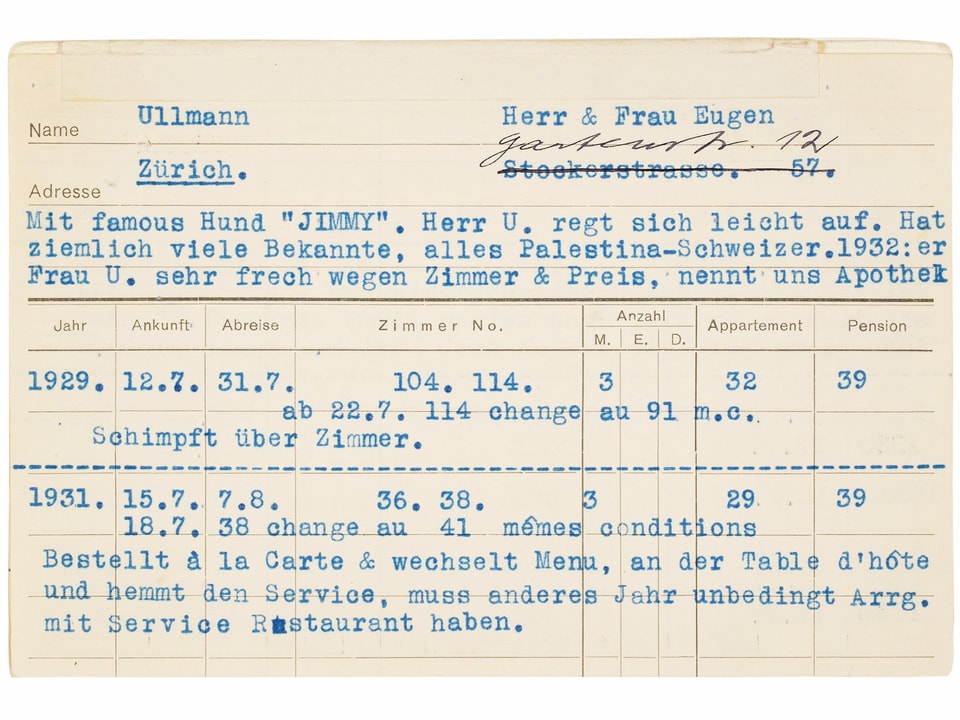
4:
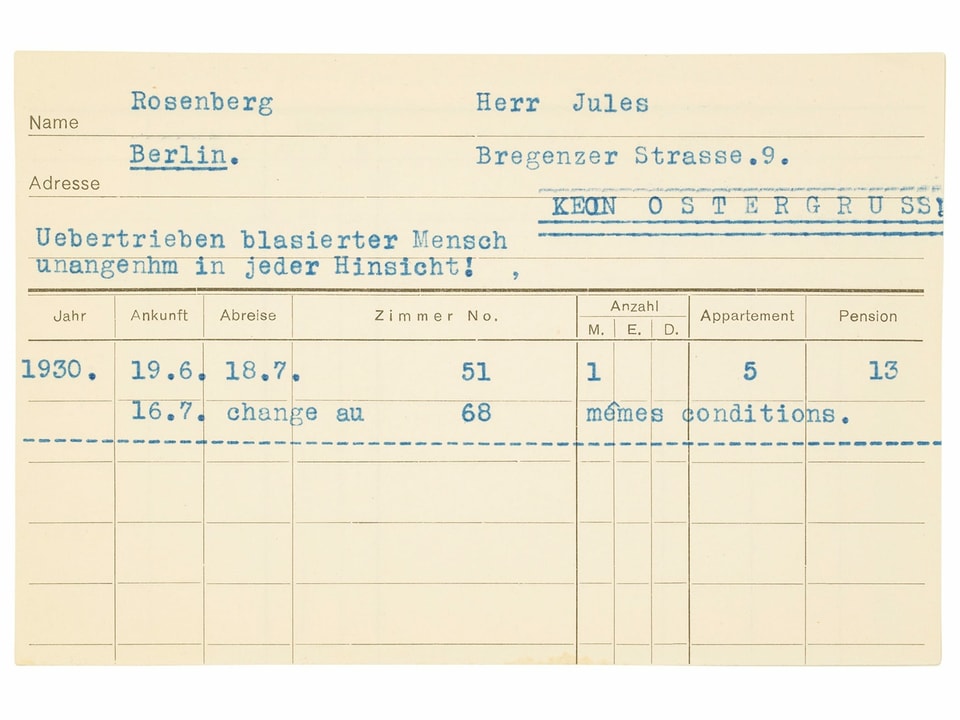
5:

6:
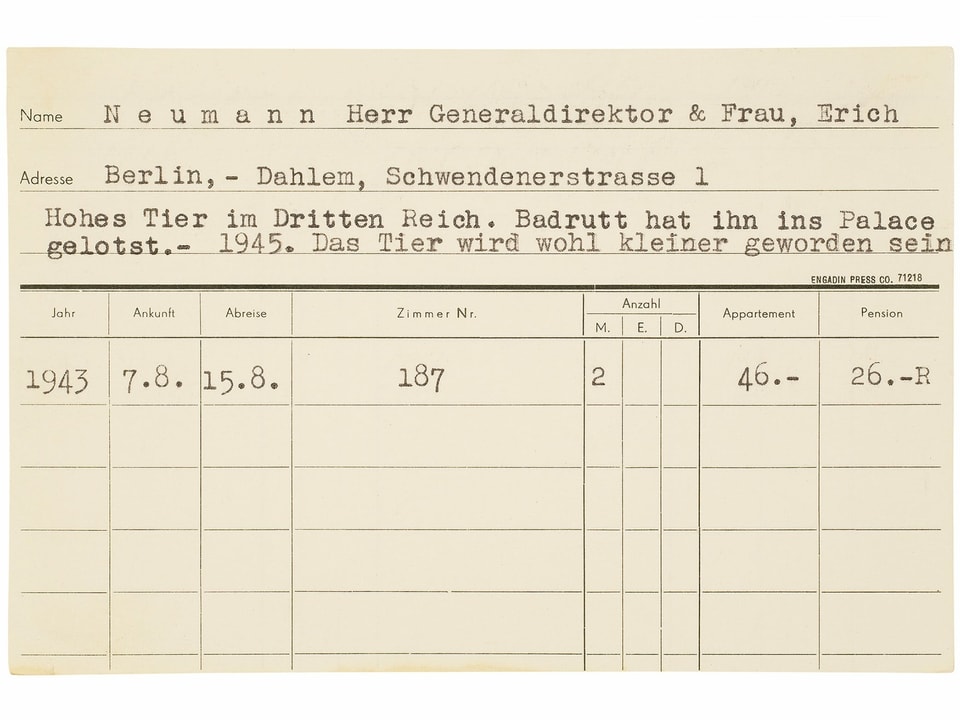
-
Die Klientel bewegte sich unter ihresgleichen und hatte keine Ahnung, dass der höfliche Concierge an der Rezeption heimlich seinem Ärger Luft machte – mittels giftiger Kommentare: «Ganz grober Kerl; treibt es arg mit den Weibern», «Grosser Protz à la Neureich», «Rappenspalter», «blöde Ziege» oder «Beisszange».
Google translate:
The clientele moved among their own kind and had no idea the polite concierge at the front desk was secretly venting his anger with venomous comments: 'Very rude fellow; does it badly with the women", "Big Protz à la Neureich", "Rappensplitter", "Stupid Goat" or "Tongs".
-
- Jan 2023
-
forum.zettelkasten.de forum.zettelkasten.de
-
Anybody using this approach to manage contacts? How?
reply to IvanFerrero at https://forum.zettelkasten.de/discussion/1740/anybody-using-this-approach-to-manage-contacts-how#latest
Many of the digital note taking tools that run off of text allow you to add metadata to your basic text files (as YAML headers, inline with a
key:: valuepair, or via #tags). Many of them have search functionality or use other programmatic means like query blocks, DataView, DataViewJS, etc. for doing queries on your files to get back lists, tables, charts, etc. of the data you're looking for.The DataView repository has some good examples of how this works with something like Obsidian. Fortunately if you're using simple text files you can usually put them into one or more platforms to get the data and affordances you want out of them individually.
As an example, I have a script block in my daily note in Obsidian for birthdays in my notes that fall on today's date:
```dataview LIST birthday FROM "Lists/People" WHERE birthday.day = date(2023-01-18).day ```If I put the text
birthday:: 1927-12-08into a note about Niklas Luhmann, his name and birthday would appear in my daily note on his birthday. One can use similar functionality to create tables of books they read with titles, authors, ratings, dates read, etc. or a variety of other data input which parses through your plaintext files. Services like Obsidian, Logseq, et al. are getting better about allowing these types of programmatic searches for users without backgrounds in programming and various communities usually provide help for pre-made little snippets like the one above that one can cut and paste into their notes to get the outputs that they need. Another Obsidian based example that uses text files for tracking academic journal articles can be found at https://nataliekraneiss.com/your-academic-reading-list-in-obsidian/; I'm sure there are similar versions for other text-based platforms.In pre-digital times, for a manual version of a rolodex like this in paper, one could use different color cards as pseudo-tags (doctors are on yellow cards, family members on blue cards, friends on green cards, etc.) or adding edge notches or even tabs to represent different types of metadata. See for example the edge colored cards in Hawkexpress' Pile of Index Cards: https://www.flickr.com/photos/hawkexpress/albums/72157594200490122
-
-
-
archive.org archive.org
-
https://archive.org/details/practicalbookkee00ellirich/page/6/mode/2up
<small><cite class='h-cite via'>ᔥ <span class='p-author h-card'>u/stockwestfale</span> in Requesting antinet hivemind assistance: ANALOG ACCOUNTING/BUDGETING/BOOKKEEPING : antinet (<time class='dt-published'>01/08/2023 12:04:20</time>)</cite></small>
-
- Dec 2022
-
www.ebay.com www.ebay.com
-
Buddy Single Drawer Index Card File Holds 1600 Cards #1335 Catalog 16" New
Wow, a new file drawer still in the box!

-
- Nov 2022
-
mycompanies.fandom.com mycompanies.fandom.com
-
Yawman & Erbe Manufacturing Company
https://mycompanies.fandom.com/wiki/Yawman_%26_Erbe_Manufacturing_Company
Some fascinating advertisements for Yawman and Erbe
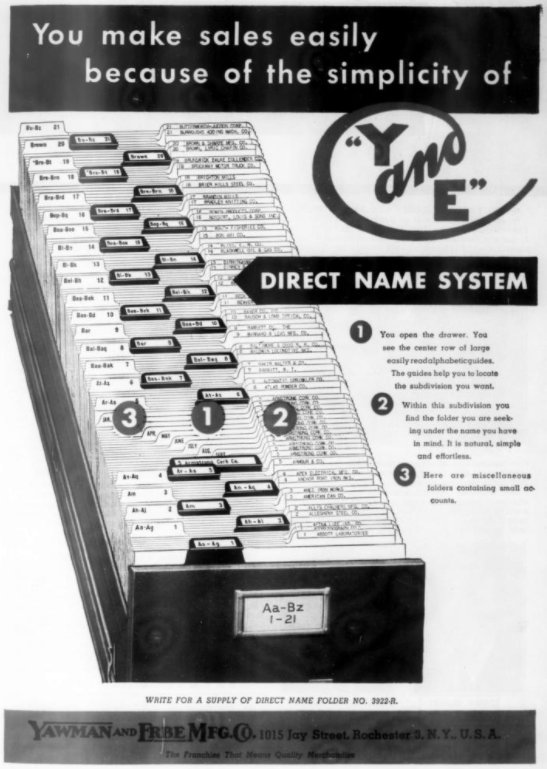
-
